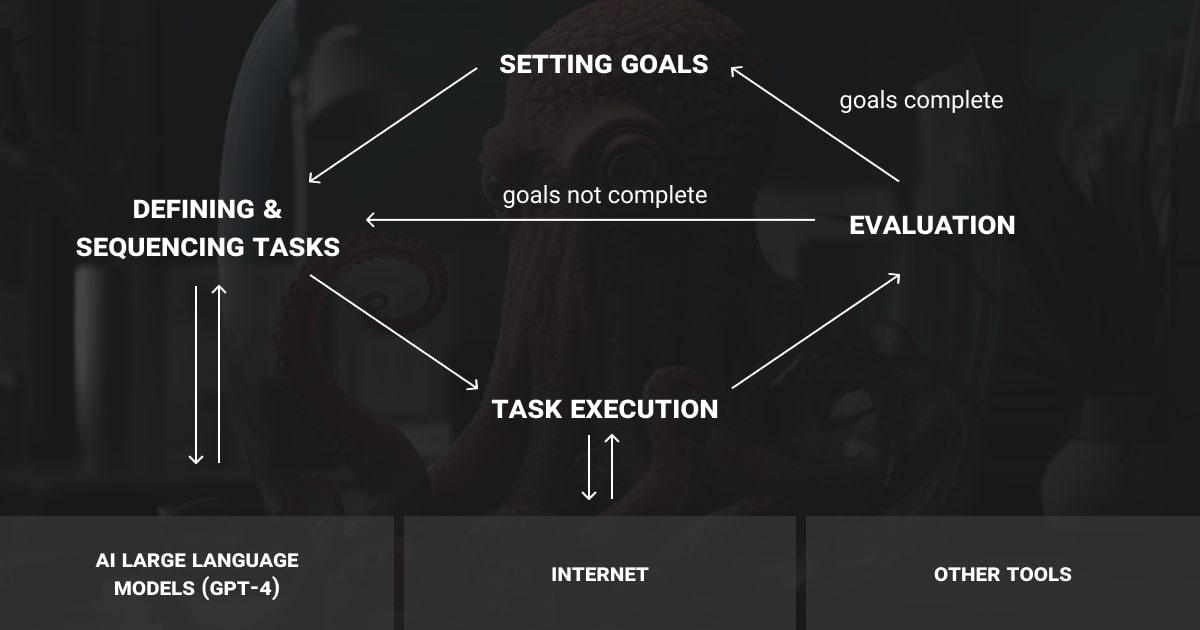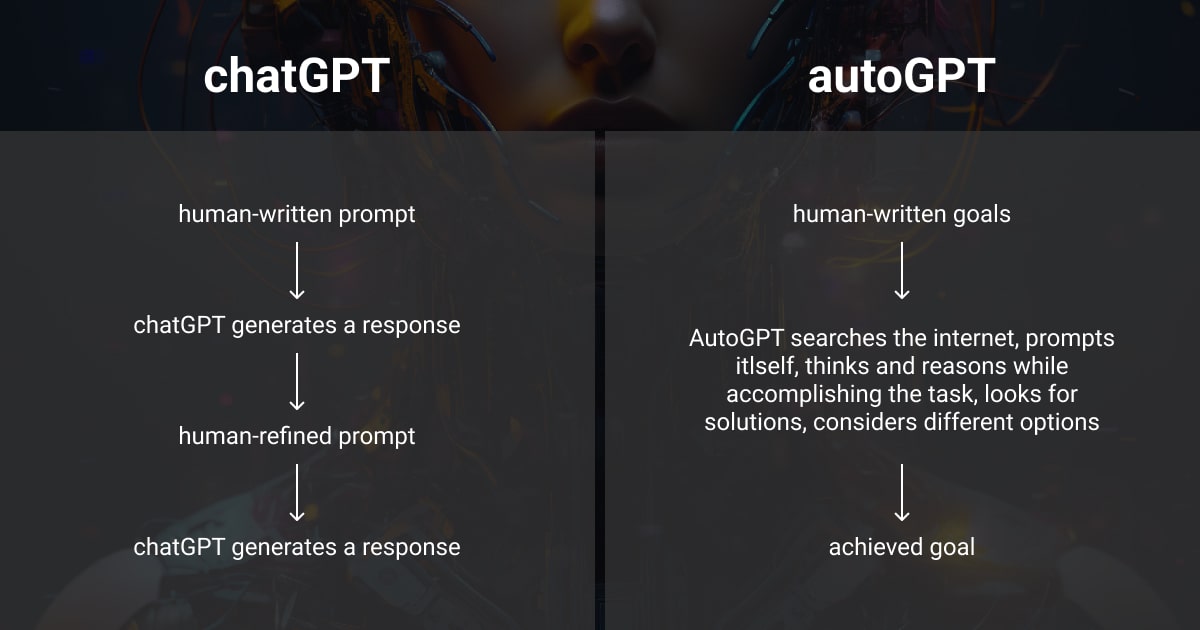Meet AutoGPT: A New, Upgraded AI Agent on the Scene
Table of Contents
- What Is All the Fuss About AutoGPT?
- The Mechanism Behind AutoGPT: How Does It Work?
- Getting AutoGPT Up and Running: Installation Guide & Exciting Features
- AutoGPT in Action: Practical Uses & Applications
- What Is the Difference between AutoGPT and ChatGPT?
- Final Thoughts on the Revolutionary AI Agent

We believed that the advent of AI chatbots like ChatGPT marked a significant milestone in automation. At this point, it feels like everyone has had a chance to experience the chatbot. The technology has captivated humanity, with over 10 million queries processed by ChatGPT every day.
However, the desire of tech enthusiasts to create new solutions and automate even more tasks continues to grow, especially with the availability of OpenAI’s APIs for using GPT models. This has led to the emergence of an enhanced version of ChatGPT called AutoGPT, which proves to be an incredibly powerful AI agent with no limitations. With only a basic understanding of programming, you too can try using AutoGPT.
If you find yourself confused about the various GPT models and how these language models work together to drive innovations like ChatGPT or AutoGPT, don’t worry. We’re here to help you sort it all out.
What Is All the Fuss About AutoGPT?

AutoGPT, the brainchild of Toran Bruce Richards, the visionary founder and lead developer at the video game company Significant Gravitas Ltd., has been creating quite a buzz. The source code for AutoGPT is freely available on Github, empowering anyone with programming know-how to create their very own AI agents.
However, AutoGPT is no ordinary AI. It can surf the internet to search and gather information, create images, manage its memory, and even talk with its text-to-speech feature. But here’s the real kicker: AutoGPT can actually rewrite and improve its own code. Imagine a program that can fix its own bugs, evolve, and become even smarter over time. It’s like having an AI that can debug, develop, and self-upgrade all by itself.
How effective these self-updates are exactly is still a bit of a mystery, but it’s definitely an exciting development to keep an eye on. AutoGPT took the internet by storm upon its launch, soaring to the top trending spot on Github with over 61,000 stars, while captivating programmers and entrepreneurs who couldn’t resist sharing their own versions and ideas about the program.
AutoGPT in Simple Terms
To help you understand AutoGPT, let’s explain what it consists of or what it represents: an AI agent, GPT, and AutoGPT itself.
Let’s start with defining an AI agent first. An AI agent refers to any artificial intelligence that can carry out specific tasks on its own, without human intervention. The term, however, is not new. Some notable examples are AI playing chess or systems controlling video game characters.
Now, let’s talk about GTP, which is short for Generative Pre-trained Transformer. In simple words, it’s a technology that tries to imitate how a human brain works. The notable distinction with AutoGPT, unlike other AI-powered chatbots that have been introduced recently, is that it doesn’t require as much human input.
While ChatGPT, Bard, or Bing require human prompts, AutoGPT is able to conduct research independently, learn from mistakes, and adapt its workload accordingly. This might suggest that it can operate at a much faster and more efficient pace compared to the human brain. Should we be concerned? Well, it does sound alarming. Some suggest that if this technology lives up to its potential, professionals in fields like customer service or journalism could face a real threat.
Naturally, we can’t ignore the risks that modern AI solutions pose to humanity. Not to mention the fact that industry leaders like Elon Musk, Steve Wozniak, and 1,700 others have signed a letter asking for a pause in the development of generative AI. And we can’t deny that AI, despite being so powerful, is still prone to bias, discrimination, lacks accountability, and poses serious privacy concerns.
But let’s focus on a great side of generative AI technology, like AutoGPT, and see the ways it can benefit society.
The Mechanism Behind AutoGPT: How Does It Work?
Let’s say you need to perform market research on various smartphones available in the market, and you want to use AutoGPT to help you out. The AI agent will conduct web searches to gather information from the internet and generate a comprehensive and well-structured output. This output will provide you with valuable insights about different smartphone models.
AutoGPT is a simulation tool that is freely available and open-source. It is an application built on the advanced GPT-4 model, incorporating automation features. The AutoGPT repository can be accessed on GitHub and is compatible with various platforms including Windows, Mac, mobile devices, and web browsers.
As you can see from the video above, AutoGPT has four important parts that make it efficient and productive. The first one is its language model called GPT-4. It’s the latest version developed by OpenAI and helps AutoGPT “think” smartly. This powerful language model can handle a wide range of tasks, from coding intricate programs to crafting beautiful poetry, and even excelling in a challenging legal examination.
OpenAI has made GPT-4 accessible through an API, which means that any developer can incorporate their powerful technology into their own creations. Auto-GPT is one of the recent products born from this API, and it could possibly be the first instance where GPT-4 is given the ability to function completely independently.
Additionally, AutoGPT employs autonomous iterations as a key feature. This allows the chatbot to identify and correct errors, as well as learn from them. It also uses vector databases as a memory storage solution. They enable the technology to store information and enhance its decision-making abilities in the future. Lastly, AutoGPT offers versatility in its functions: it can swiftly browse the internet, retrieve and store data, and even make edits to data files when needed.
Getting AutoGPT Up and Running: Installation Guide & Exciting Features

AutoGPT operates through four key components:
- Architecture: AutoGPT uses the robust GPT-4 and GPT-3.5 language models as its architecture for text generation. They serve as the robot’s cognitive center, enabling it to think and reason effectively.
- Autonomous iterations: The AI agent possesses autonomous iterations, allowing it to learn from mistakes. It can review its own work, improve upon previous attempts, and leverage its history to generate more precise outcomes.
- Long-term and short-term memory management: By integrating vector databases as a memory storage solution, AutoGPT retains context and enhances decision-making. It’s similar to providing the robot with a long-term memory, enabling it to recall past experiences.
- Multi-functionality: AutoGPT stands out through its versatility. It can perform various tasks like manipulating files, browsing the web, and retrieving data. This diverse skill set sets it apart from previous AI advancements, expanding its range of capabilities.
An additional feature is that this tool is equipped with Internet connectivity, allowing it to browse and gather information from well-known websites and platforms. Although AutoGPT is accessible to everyone, it requires some programming skills to set up. Luckily, users have developed AgentGPT, a tool that seamlessly incorporates AutoGPT into web browsers. This enables anyone to create their own AI agents without any cost involved.
Currently, the technology does have some problems. For instance, ChatGPT has been found to create fake news articles or scientific studies. Similarly, AutoGPT has faced difficulties in staying focused on the assigned task. But if you’re eager to test out the tool and run AutoGPT on your device, we’ve gathered some useful sources to help you accomplish the task:
AutoGPT in Action: Practical Uses & Applications
To put it simply, AutoGPT excels in various text-related tasks. It can produce human-like, quality text, summarize extensive texts, respond to questions, and even perform language translations. Additionally, the tool proves useful in tasks like text classification, sentiment analysis, and NER (named entity recognition).
AutoGPT’s capabilities have a wide range of applications, including chatbots, virtual assistants, and language learning tools. As a result, industries such as marketing research, content creation, and software development can utilize AutoGPT to meet their specific requirements. But let’s look at some general tasks that AutoGPT is capable of performing various in more detail:
- Content creation: generating articles, landing pages, stories, poems, songs, writing text for podcasts, product reviews (and research), or social media posts.
- Data analysis: handling, visualizing, and comprehending vast quantities of data originating from diverse sources.
- Web development: creating, coding, and deploying of websites and web applications with minimal human intervention, streamlining the web development process.
- Lead generation: exploring and identifying potential leads and prospects for sales purposes.
- Investment opportunities analysis: conducting market research and evaluating online discussions to identify intelligent investment options through sentiment analysis.
- Business plan development: generating a comprehensive business plan to facilitate growth.
- Education: supporting your learning journey by offering tailored feedback and guidance, facilitating the acquisition of new skills, concepts, and languages.
- Entertainment purposes: generating jokes, games, trivia, or any other content that brings you joy and amusement.
What Is the Difference between AutoGPT and ChatGPT?

At this point, you might think that AutoGPT is not that different from ChatGPT, since they both are AI chatbots and both perform automated text generation based on the specific user request. While this is true, there are a few significant differences between the two, and we’d like to discuss them in greater detail.
Similarities
AutoGPT and ChatGPT share the same foundational back-end infrastructure, using OpenAI’s GPT-3.5 and GPT-4 language models. Also, while ChatGPT was directly developed by OpenAI, AutoGPT was created leveraging OpenAI’s APIs (although, you might argue this is a difference between the two).
Differences
In contrast to ChatGPT, AutoGPT operates in a loop. This means that it divides tasks into smaller subtasks, prompts itself, generates a response, and repeats this cycle until it accomplishes the given objective. ChatGPT, as we already know, relies on repeated prompting from the user. OpenAI's chatbot lacks an overarching goal to follow and primarily relies on the series of prompts that we provide to it.
Another distinction is that AutoGPT employs short-term memory management to retain context and facilitate the model’s handling of lengthy prompt sequences. ChatGPT, however, lacks inherent memory capabilities, and information does not persist between sessions. And perhaps the most important difference between AutoGPT and ChatGPT is that the former has Internet access, and the latter does not have that ability to surf online sources.
This makes AutoGPT an amazing tool for market research or any other research you need, given that it can do it all for the user. ChatGPT, conversely, has been trained on data that does not go beyond September 2021, as indicated in its interface below. Thus, the chatbot is not able to provide any information after that period, so most of the information is not up-to-date and relevant.
One more essential feature that AutoGPT has is that it can accept input in the form of both text and images. ChatGPT is unable to do so, as it only works with text data. But we saved the best for last: Auto-GPT includes code improvement, as it can read, write, execute, evaluate, test, and update code to enhance its own programming by making it faster and more efficient.
Final Thoughts on the Revolutionary AI Agent

As we explore the world of new generative AI technology, a pressing question comes to mind: Does life become easier with AI agents like AutoGPT?
Let’s face it: AutoGPT is incredible, capable of performing a wide range of tasks that we could only dream of since the days of ChatGPT. These smart agents are just as independent, but their abilities are even more impressive thanks to cutting-edge models like GPT-4.
However, we must exercise caution when it comes to such unlimited automation. The growing presence of such tools in our lives is believed to pose a threat to many jobs today, leaving us concerned about the potential takeover by AI. While this is not a current reality or an immediate concern, it’s important to note that AI development is not possible without careful human supervision. That's our answer to all the AI concerns we hear these days.
Need annotated data for your AI project? Contact Label Your Data! Our experts provide professional data annotation and processing services for NLP and Computer Vision projects.
Don’t forget, ChatGPT was also trained on labeled data ;)
Written by
Karyna is the CEO of Label Your Data, a company specializing in data labeling solutions for machine learning projects. With a strong background in machine learning, she frequently collaborates with editors to share her expertise through articles, whitepapers, and presentations.

